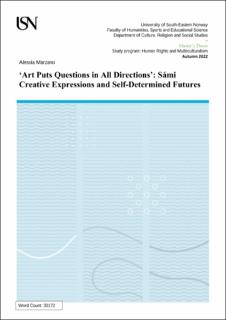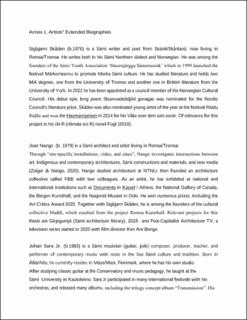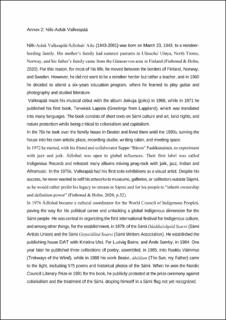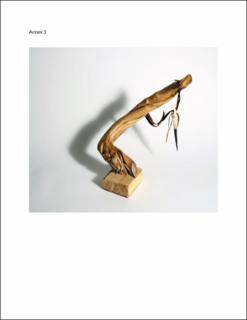| dc.description.abstract | Inspired by Nils-Aslak Valkeapӓӓ’s (in Sámi: Áillohaš, 1943-2001) ecocritical perspective and strong critique of Western colonialism and capitalism, this study seeks to address the multidimensionality of Sámi contemporary creative expressions and identities, challenging the one-dimensionality that often comes out when associating a strong political/activist dimension to Sámi artistic practices, while aiming at filling the existing gap between theoretical and academic understandings of decoloniality/indigenization – the what- and the way different Sámi artists relate to them in their practices - the how.
Through conversations with six Sámi artists residing on the Norwegian side of Sápmi, this study reflects on the statement “Indigenous art is inherently political” (Martineau & Ritskes, 2014, p.1) seeking to investigate the role of Sámi creative expressions in decolonizing and/or indigenizing Sápmi and imagining possible pluriversal futures. In doing so, it questions whether Sámi creative practices should be inherently considered political, further inquiring if and how the Sámi artists who participated in the conversations relate their artistic expressions to the activism/artivism framework, and what is the role of Nils-Aslak Valkeapӓӓ/ Áillohaš in imagining self-determined futures.
The role of Sámi creative expressions is hereby analyzed within a decolonial framework in relation to cultural self-determination and Sámi sovereignty as the right to pursue Sámi self-determined futures. Throughout the process, a crucial role was given to positionality and ethical principles connected to conducting research with Indigenous peoples. The epistemological and methodological stances are attuned, in this regard, to decolonizing methodologies, critical arts-based research, and inspired by the values of Indigenous methodologies. The conversations were analyzed and coded using reflexive thematic analysis. Three themes, divided in ten subthemes - were designed, after coding the in-depth conversations, especially in relation to the role Valkeapää had in shaping Sámi artistic identities, together with the expectations and stereotypes of being a Sámi artist; the role that Sámi creative practices play for the participants artists, in questioning Western development, and in posing radical questions while creating spaces as futures. The thesis focuses on the concept of epistemicide (Santos, 2016) - also evident in the essentialization of Sámi creative practices and identities- and the importance of epistemic reconstitution (Quijano, 2007). This is done by foregrounding Sámi creative practices in their multidimensionality, beyond the reductive framing of creativity as “instrumental to an explicitly stated politics or political project” (Martineau & Ritskes, 2014, p.3) and exploring the “liberating potentialities” (p.3) of Sámi creative practices.
Acknowledging the crucial role of Sámi creative practices in imagining, and shaping tself-determined futures, is crucial to fill the gaps left by legal definitions of sovereignty and self-determination. Hence, Sámi creative expressions can be political in a transformative way, and not “in a restrictive and hegemonic sense” (J.Nango, conversation, December 17, 2021) without being overtly activist. | |



